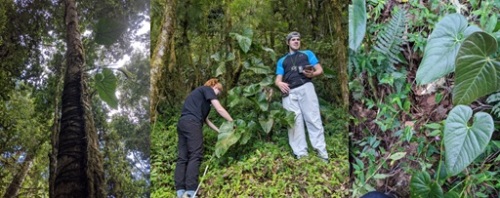
Madison Deile and Brady Hartman study tradeoffs in epiphytic (left) versus terrestrial (right) Anthurium.
Study by Nate Bennett, Madison Deile, Brady Hartman, and Logan Goettl.
The Anthurium anturio plant is native to the Latin American Cloud Forests and is commonly used for cooking at high elevations in Costa Rica. Anthurium anturio can grow both epiphytically and terrestrially in the region surrounding Cuerici Biological Station. We were curious about how various ecological and biological factors differ between the two behaviors of the plant. We measured chlorophyll content, base stem diameter, total leaf area, leaf number, flower number, canopy cover, and height relative to the forest floor of both epiphytic and terrestrial behaving plants. A total of 72 terrestrial and 68 epiphytic plants were sampled in our study. We predicted all but stem diameter and height would be equal between the two behaviors, and there would be interactive effects between factors. We found epiphytic plants were more prevalent in areas with high canopy density, likely because their height gave them a competitive advantage in capturing sunlight. Additionally, terrestrial plants had a greater stem width than epiphytic plants of similar height. Furthermore, all factors had interactive effects except for number of leaves and canopy density. Lastly, there was not a significant relationship between canopy density and chlorophyll content. This data could be used to further investigate how Anthurium anturio allocate their resources for optimal growth. Future research could account for changes in elevation and age of plants to better explain these energy tradeoffs.

Study conducted by (from L to R) Brady Hartman, Madison Deile, Logan Goettl, and Nate Bennett.
Leave a comment